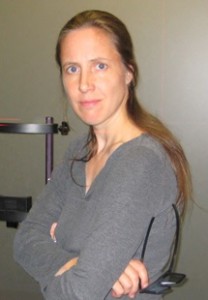Plenary Sessions
Plenary session 1: Thursday, July 9th, 8:30 to 9h15:
The Evolution of Digital Media – Towards Immersive and Interactive Experiences
by Oliver Grau, Intel GmbH, Germany
Plenary session 2: Friday, July 10th, 8:35 to 9h20:
What is stereoscopic vision good for?
by Jenny C. A. Read, Institute of Neuroscience, Newcastle University, UK
Plenary session 1
The Evolution of Digital Media – Towards Immersive and Interactive Experiences
Presented by Oliver Grau
Intel GmbH, Germany
July 9th, 8:30 to 9h15
Abstract:
The first part of the presentation gives a brief overview of how digitalization led to a number of evolutionary steps in media industry in the last decades. In particular broadcast has recently seen an unrivaled development from only standard resolution video to HD and now 4k within just one decade and 8k standards are already trialed. Cinema industry was successfully adopting stereoscopic 3D to re-gain attention of audiences, but this trend is now in decline. The second part raises then the question what are the next innovations in media. Contenders are: High-frame rate, HDR imaging and most of all: Full 3D immersion and (more) interaction. The interest in the latter two aspects has been fuelled by recent advantages in display and computing technologies, with a new generation of head-mounted devices and the promise to revitalize VR. However, these devices will only be successful as products if also attractive content or applications are introduced with them. We therefore also look into what tools are available and/or missing to satisfy this demand.
Biography:
Oliver Grau joined Intel as Associate Director of Operations of the Intel Visual Computing Institute in Germany in October 2012. He received a PhD from the University of Hanover, Germany in 1999. Prior to Intel he worked for BBC R&D in the UK on innovative tools for visual media production. Since 2013 he is a visiting professor at the University of Surrey, UK. Oliver’s research interests are in the intersection between computer vision and computer graphics techniques. His prior work included immersive virtual production systems, stereoscopic video production tools, free-viewpoint visualization of sport scenes and web-delivery of free-viewpoint experiences. More recent research interests include visual computing for new user experiences and digital content creation tools. Oliver has a long track history of leading interdisciplinary work in more than 10 major collaborative projects, between academical and industrial partners. Oliver published a number of scientific papers and holds several patents.
Plenary session 2
What is stereoscopic vision good for?
Presented by Jenny C. A. Read
Institute of Neuroscience, Newcastle University
Friday, July 10th, 8:35 to 9h20
Abstract:
Stereoscopic vision has been described as “one of the glories of nature”. Humans can detect disparities between the two eyes’ images which are less than the diameter of one photoreceptor. But when we close one eye, the most obvious change is the loss of peripheral vision rather than any alteration in perceived depth. Many people are stereoblind without even realising the fact. So what is stereoscopic vision actually good for? In this wide-ranging keynote address, I will consider some possible answers, discussing some of the uses stereo vision may have in three different domains: in evolution, in art and in medicine.
Stereo vision incurs significant costs, e.g. the duplication of resources to cover a region of the visual field twice, and the neuronal tissue needed to extract disparities. Nevertheless, it has evolved in many animals including monkeys, owls, horses, sheep, toads and insects. It must therefore convey significant fitness benefits. It is often assumed that the main benefit is improved accuracy of depth judgments, but camouflage breaking may be as important, particularly in predatory animals. I will discuss my lab’s attempts to gain insight into these questions by studying stereo vision in an insect system, the praying mantis.
In humans, for the last 150 years, stereo vision has been turned to a new use: helping us reproduce visual reality for artistic purposes. By recreating the different views of a scene seen by the two eyes, stereo achieves unprecedented levels of realism. However, it also has some unexpected effects on viewer experience. For example, by reducing the salience of the picture surface, it can affect our ability to correct for factors such as oblique viewing. The disruption of established mechanisms for interpreting pictures may be one reason why some viewers find stereoscopic content disturbing.
Stereo vision also has uses in ophthalmology. The sub-photoreceptor level of stereoacuity referred to in my opening paragraph requires the entire visual system to be functioning optimally: the optics and retina of both eyes, the brain areas which control eye movements, the muscles which move the eyes, and the brain areas which extract disparity. Thus, assessing stereoscopic vision provides an immediate, non-invasive assessment of binocular visual function. Clinical stereoacuity tests are used in the management of conditions such as strabismus and amblyopia as well as vision screening. Stereoacuity can reveal the effectiveness of therapy and even predict long-term outcomes post surgery. Yet current clinical stereo tests fall far short of the accuracy and precision achievable in the lab. At Newcastle we are exploiting the recent availability of autostereo 3D tablet computers to design a clinical stereotest app in the form of a game suitable for young children. Our goal is to enable quick, accurate and precise stereoacuity measures which will enable clinicians to obtain better outcomes for children with visual disorders.
Biography:
Jenny Read leads a multidisciplinary team researching many aspects of vision, especially 3D or stereoscopic vision. Her research interests include how vision may be altered in clinical conditions like strabismus or epilepsy, how viewers perceive depth in 3D displays, and how 3D vision works in insects. Read’s scientific career began with a doctorate in theoretical astrophysics at Oxford University before moving into visual neuroscience. After four years in the USA working at the National Institutes of Health, in 2005 she returned to the UK with a research fellowship from the Royal Society, Britain’s national academy of science. She is now a Reader (Associate Professor) in Vision Science at Newcastle University’s Institute of Neuroscience in the beautiful North East of England.
